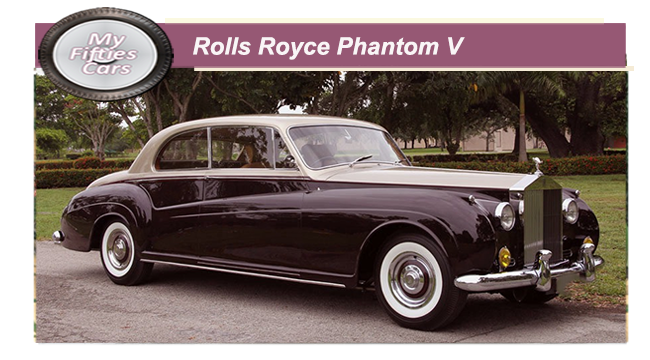
Among the many signals that the global economy had finally emerged from post-war austerity was the announcement in 1959 that Rolls-Royce would be reviving their Phantom with the introduction of the Phantom V.
More significant about the planned release, was that it marked the first time that Phantoms had been made available for purchase by members of the general public since the prewar years.
The Rolls-Royce Phantom V mechanical specifications were very similar to that of the Silver Cloud II, sharing both its V8 engine as well as its four-speed Hydramatic gearbox.
Rolls-Royce Phantom V mechanical specifications were very similar to that of the Silver Cloud II, sharing both its V8 engine as well as its four-speed Hydramatic gearbox.
 The Phantom’s chassis had been both lengthened and strengthened providing potential clients with the opportunity to purchase a long wheelbase vehicle of the highest class, all this time around not only reserved to the upper echelons of society throughout the world, but also to private individuals.
The Phantom’s chassis had been both lengthened and strengthened providing potential clients with the opportunity to purchase a long wheelbase vehicle of the highest class, all this time around not only reserved to the upper echelons of society throughout the world, but also to private individuals.
 Those fortunate people needed to have particularly deep pockets to foot the bill for a car which provided tremendous prestige with each alongside exceptional convenience, incredible comfort and previously unprecedented levels of head and leg room.
Those fortunate people needed to have particularly deep pockets to foot the bill for a car which provided tremendous prestige with each alongside exceptional convenience, incredible comfort and previously unprecedented levels of head and leg room.
![]()
The chassis on the Phantom V was based on a lengthened version of the Silver Cloud, while the car to be specified with a varied choice of coachwork designs.
 The most popular of these designs over the year came from renowned UK master body builder HJ Mulliner. The best selling body permutationfrom Mulliner was their six-light styling, usually painted in a shining black.
The most popular of these designs over the year came from renowned UK master body builder HJ Mulliner. The best selling body permutationfrom Mulliner was their six-light styling, usually painted in a shining black.
The Phantom V was also one of the largest cars ever to emerge from the manufacturers' workshops in Crewe, tipping the scales at almost 3000kg (around three tons), the Phantom V had a 3.6m (12ft) wheelbase and enormous passenger space in the rear.
M echanically the Rolls-Royce Phantom V was the first to be fitted with the company's in-house developed all-alloy familiar 6.3-litre (380 Cu in) V8 engine, with twin SU carburettors, coupled with 4-speed automatic transmission.
echanically the Rolls-Royce Phantom V was the first to be fitted with the company's in-house developed all-alloy familiar 6.3-litre (380 Cu in) V8 engine, with twin SU carburettors, coupled with 4-speed automatic transmission.
 This winning combination which went on to power several more of the company’s models over the coming decades.
This winning combination which went on to power several more of the company’s models over the coming decades.
.Rolls-Royce at that point had taken pity on all drivers by fitting power steering as standard in the Phantom V as well as automatic transmission.
![]()
W ith the fuel crisis of the mid-Fifties now confined to history, drivers barely noticed that fuel consumption for the car was very high.
ith the fuel crisis of the mid-Fifties now confined to history, drivers barely noticed that fuel consumption for the car was very high.
 A total of 516 Phantom V's were produced during the seven-year production cycle with among the notable were Queen Elizabeth II and her mother, Queen Elizabeth, the Queen Mother and the late John Lennon who famously treated his Phantom V to a custom paint job based on the style of a Romany gipsy wagon.
A total of 516 Phantom V's were produced during the seven-year production cycle with among the notable were Queen Elizabeth II and her mother, Queen Elizabeth, the Queen Mother and the late John Lennon who famously treated his Phantom V to a custom paint job based on the style of a Romany gipsy wagon.


